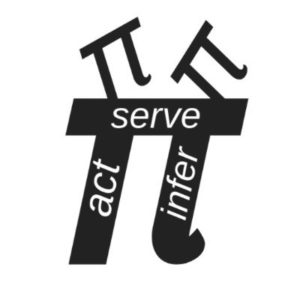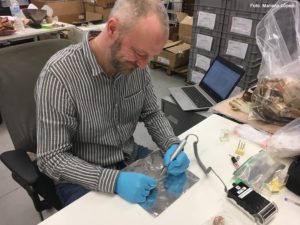Category Archives: Actividades
Life and death in the Arrabal of Arrixaca
Life and death in the Arrabal of Arrixaca.
María Haber professor of Prehistory at the University of Murcia and Vice Chair of Mupantquat, based on the remains found in the cemetery of the San Esteban archaeological site, and as director of Anthropology of the research project, explains briefly in spanish what can be known about the life of the ones that were buried there through his bones.
MUPANTQUAT in the Murcian Region in 2012-2013
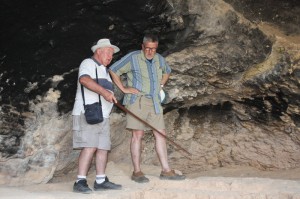 Following official registration in Murcia of our Association on June 27th 2012, the first official MUPANTQUAT activity took place during our excavations at Cueva Negra del Estrecho del Río Quípar on July 19th 2012. It took the form of a reception with invited guests held at a nearby hotel for Professor Bernard Wood of George Washington University who was invested as the Association’s first Honorary Member, accompanied by a preview of the animated documentary film “Cueva Negra” produced by the public Murcian Integra Foundation, the scientific basis for which was provided by our excavation findings at Cueva Negra.
Following official registration in Murcia of our Association on June 27th 2012, the first official MUPANTQUAT activity took place during our excavations at Cueva Negra del Estrecho del Río Quípar on July 19th 2012. It took the form of a reception with invited guests held at a nearby hotel for Professor Bernard Wood of George Washington University who was invested as the Association’s first Honorary Member, accompanied by a preview of the animated documentary film “Cueva Negra” produced by the public Murcian Integra Foundation, the scientific basis for which was provided by our excavation findings at Cueva Negra.
The excavations and research of MUPANTQUAT are the scientific underpinning of the animated documentary film “Cueva Negra”, produced at Murcia by the public Integra Foundation. The film was honoured in the 16th Málaga Film Festival of 2013 () by being shown in the festival’s “Animazine” section, which highlights Spanish talent in animated documentary film-making, following its selection for the privilege by President Carlos Biern of Spain’s Federation of Animaled Film Producers. The film can be seen on our web-site and it is freely available in the Murcian Region for showing in schools and other institutions on application to the Integra Foundation.
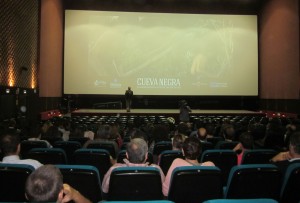 At Murcia on October 20th 2012 “Cueva Negra” was shown in public for the first time, at the Regional Film Theatre in the city (with no charge for entry), at which MUPANTQUAT members attended. MUPANTQUAT arranged with the Integra Foundation for there to be further public showings with free entry, each followed by round-table seminars in which MUPANTQUAT members explained scientific aspects of the site to the public. These events took place in various cities and towns in the Murcian Region as follows:
At Murcia on October 20th 2012 “Cueva Negra” was shown in public for the first time, at the Regional Film Theatre in the city (with no charge for entry), at which MUPANTQUAT members attended. MUPANTQUAT arranged with the Integra Foundation for there to be further public showings with free entry, each followed by round-table seminars in which MUPANTQUAT members explained scientific aspects of the site to the public. These events took place in various cities and towns in the Murcian Region as follows:
December 19th 2012, Caravaca Municipal “Thuillier” Theatre;
January 24th 2013, Murcia Archaeological Museum lecture theatre;
February 21st 2013, Cartagena Municipal Archaeological Museum lecture theatre;
March 20th 2013, Lorca “CajaMurcia” auditorium;
April 26th 2013, Mula Municipal Archaeological Museum lecture theatre, when Professor Joao Zilhao of Barcelona University was invested as the Association’s second Honorary Member in recognition of the Palaeolithic excavations he has conducted at sites in Mula;
May 20th 2013, Molina de Segura “Las Balsas” Cultural Centre.
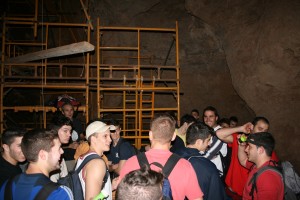 Guided excursions to Sima de las Palomas del Cabezo Gordo were conducted by members of MUPANTQUAT who gave explanatory talks in the field, on the following dates:
Guided excursions to Sima de las Palomas del Cabezo Gordo were conducted by members of MUPANTQUAT who gave explanatory talks in the field, on the following dates:
November 16th 2012 (a large group of second-year Murcia University undergraduates studying Prehistory);
February 2nd 2013 (a group of students and interested visitors from Cartagena);
March 8th 2013 (a group of students and teachers from the Murcia University Faculty of Sport Science);
November 29th 2013 (a large group of second-year Murcia University undergraduates studying Prehistory).
To those we must add the extremely well-attended public visits on our Open Day July 21st 2013 at Cueva Negra and our Open Day August 11th 2013 at Sima de las Palomas when over five hundred people visited the site.
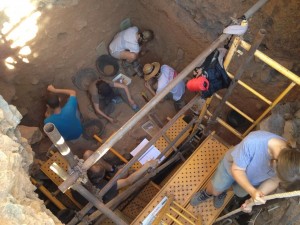 Our 6-week excavation campaign from July 2nd to August 13th 2013 was extremely successful; as usual, the first 3 weeks were at Cueva Negra and the following 3 weeks at Sima de las Palomas. We had helpers from Spain, the UK, Sweden, Switzerland, Belgium, Germany, Canada, USA, Hong Kong and Australia. You will find out more about our excavations if you click on FIELD SCHOOL where you will find information about the forthcoming 2014 excavations. The Field School and its excavations are largely self-funded, which has permitted them to take place year after year despite lack of public funding. Our self-funded Field School seems to be the best way forward that we have found to date to advance our aims.
Our 6-week excavation campaign from July 2nd to August 13th 2013 was extremely successful; as usual, the first 3 weeks were at Cueva Negra and the following 3 weeks at Sima de las Palomas. We had helpers from Spain, the UK, Sweden, Switzerland, Belgium, Germany, Canada, USA, Hong Kong and Australia. You will find out more about our excavations if you click on FIELD SCHOOL where you will find information about the forthcoming 2014 excavations. The Field School and its excavations are largely self-funded, which has permitted them to take place year after year despite lack of public funding. Our self-funded Field School seems to be the best way forward that we have found to date to advance our aims.
Growing interest in our activities has been stimulated both by the “Cueva Negra” animated film and most particularly by the considerable space and attention devoted to Sima de las Palomas in the scientific documentary film “Decoding Neanderthals” shown by PBS-NOVA in the USA on January 9th 2013 (you may be able to see this on our web-site or else try going to http://video.pbs.org/video/2323758207) made by London-based “Arrow Productions” which filmed with us at the site.
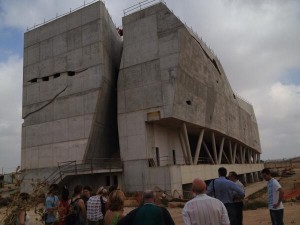 Unfortunately the economic crisis in Spain led to cancellation of some public projects we had hoped to carry out. On January 8th 2013, during a visit to the newly constructed building that will soon house the Murcian Regional Museum for Palaeontology and Human Evolution below Sima de las Palomas, MUPANTQUAT acceded, albeit with some misgivings, to a request to run a 5-day course about the site and its Neanderthals. It was to have been held in May under the auspices of the local Torre Pacheco town council and Murcia University’s “UniMar” department that runs summer school courses, because together they had agreed to support courses at that town near the site. However, “UniMar” was unable to attract the minimum number of students required for it to allow the course to go ahead, despite charging them only a modest 80-euro attendance fee; nor yet could it do so after we agreed to its request to postpone the course to September in the hope of more enrolments.
Unfortunately the economic crisis in Spain led to cancellation of some public projects we had hoped to carry out. On January 8th 2013, during a visit to the newly constructed building that will soon house the Murcian Regional Museum for Palaeontology and Human Evolution below Sima de las Palomas, MUPANTQUAT acceded, albeit with some misgivings, to a request to run a 5-day course about the site and its Neanderthals. It was to have been held in May under the auspices of the local Torre Pacheco town council and Murcia University’s “UniMar” department that runs summer school courses, because together they had agreed to support courses at that town near the site. However, “UniMar” was unable to attract the minimum number of students required for it to allow the course to go ahead, despite charging them only a modest 80-euro attendance fee; nor yet could it do so after we agreed to its request to postpone the course to September in the hope of more enrolments.
Our Association is disappointed and frustrated, having spent much time and effort in arranging, and then rearranging the course, the lecturers and instructors, and holding numerous meetings with the institutions. It was time and effort that with hindsight could better have been devoted to organizing other less demanding events and activities. As a last resort, MUPANTQUAT and Torre Pacheco town council entered the course, unsuccessfully, in a national competition for Spanish government sponsorship of the public diffusion of science, sponsorship much restricted in 2013 by the severity of government budgetary cuts. At the root of these frustrating experiences is the dire economic situation of public finances in Spain. We repeat: our self-funded Field School is undoubtedly the best way forward that we have encountered to date.
 Among other matters to which we have had to devote time and energy in 2013 mention must be made of institutional agreements of collaboration and cooperation that we have signed with Murcia University, the Murcian Archaeological Museum and the Murcian Regional Geographical Society and other associations. Developing the exact terms and precise clauses that are to be annexed to the Agreement of collaboration with the Murcia University is also involving numerous interminable meetings with university administrative officers.
Among other matters to which we have had to devote time and energy in 2013 mention must be made of institutional agreements of collaboration and cooperation that we have signed with Murcia University, the Murcian Archaeological Museum and the Murcian Regional Geographical Society and other associations. Developing the exact terms and precise clauses that are to be annexed to the Agreement of collaboration with the Murcia University is also involving numerous interminable meetings with university administrative officers.
Because the aims of MUPANTQUAT include both scientific research and public diffusion of scientific knowledge, another matter that at present is occupying much of our members’ time is the packaging and temporary storage of all the finds excavated at Cueva Negra and Sima de las Palomas so that they can be transferred from their present location at Murcia University’s Physical Anthropology laboratory to the future Murcian Regional Museum for Palaeontology and Human Evolution below Sima de las Palomas as soon as its store-rooms, laboratories, and exhibition rooms have been fitted out and equipped to house them, hopefully during 2014.
Underlying this time-consuming labour is the desire, both on our part and that of the Murcia regional government’s Directorate-General for Heritage, to have the material ready and waiting for immediate transfer, so that it will stimulate and pressure the company charged with carrying out the work inside the new building to expedite it with the utmost urgency; the company is under contract to Torre Pacheco town council to which the Murcian regional government had transferred eight million euros for the project in 2006. The first stone was laid in September 2010 and two years later the imposing 5-storey structure was completed (1,000 square metres on each floor) but still it remains unfinished inside. Both we and the Director General are impatient to have the museum finished and functioning. He therefore has made available to us a temporary, rented, storage facility that is spacious, well-lit and satisfactory for our ongoing research needs. At the same time, however, its temporary, rented nature represents an ever-present reminder to the building contractors that they must finish their work speedily, now that material is ready and waiting to be transferred to the new museum for public display in exhibition galleries, as well as for ongoing scientific research in its new laboratories. (It goes without saying that we are also involved, at the same time, with the usual routine tasks of continuing research on the material we have excavated, as well as documenting it and preparing official reports and scientific articles.)
We hope, very soon now, to put in the hands of our printers the Spanish edition of a profusely-illustrated popular-science book about our excavations and research at Cueva Negra and Sima de las Palomas, called in English “How the Earliest Cave-Folk of South-East Spain were Dug up”. MUPANTQUAT is itself the publisher of the Spanish edition and we have had meetings with Oxbow Books about the English edition. We have been fortunate in finding some sponsors to help us defray the cost of printing the Spanish edition which we anticipate will help us to attract new members throughout the Murcian Region and beyond. Preparation of the edition has suffered from delay in 2013 owing to dispersal of our energies in trying, fruitlessly, to organize public courses with Torre Pacheco town council and “UniMar” (see above).
Independent initiatives seem to offer a surer way forward. MUPANTQUAT is taking that route, and to help smooth the path we are actively seeking partnerships with business and agreements with independent organizations. We want to expand our horizons and extend the scope of activities in which our members and supporters can fully participate.


